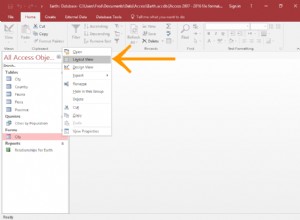Eu estava procurando uma solução semelhante em conceito pelo menos à de Wernfried, mas acho que é diferente o suficiente para postar também. O início é a mesma ideia, primeiro gerando os possíveis intervalos de tempo e supondo que você esteja olhando para janelas de 15 minutos:estou usando CTEs porque acho que são mais claras do que seleções aninhadas, principalmente com tantos níveis.
with date_time_range as (
select to_date('10/10/2013 07:00', 'DD/MM/YYYY HH24:MI') as date_start,
to_date('10/10/2013 21:15', 'DD/MM/YYYY HH24:MI') as date_end
from dual
),
time_slots as (
select level as slot_num,
dtr.date_start + (level - 1) * interval '15' minute as slot_start,
dtr.date_start + level * interval '15' minute as slot_end
from date_time_range dtr
connect by level <= (dtr.date_end - dtr.date_start) * (24 * 4) -- 15-minutes
)
select * from time_slots;
Isso oferece 57 intervalos de 15 minutos entre a data de início e término que você especificou. O CTE para
date_time_range não é estritamente necessário, você pode colocar suas datas diretamente em time_slots condições, mas você teria que repeti-las e isso introduz um possível ponto de falha (e significa vincular o mesmo valor várias vezes, do JDBC ou de qualquer outro lugar). Esses slots podem então ser cruzados com a lista de salas de aula, que estou assumindo que já estão em outra tabela, que fornece 171 (3x57) combinações; e eles podem ser comparados com as reservas existentes - uma vez eliminadas, você fica com os 153 slots de 15 minutos que não têm reserva.
with date_time_range as (...),
time_slots as (...),
free_slots as (
select c.classroom, ts.slot_num, ts.slot_start, ts.slot_end,
lag(ts.slot_end) over (partition by c.classroom order by ts.slot_num)
as lag_end,
lead(ts.slot_start) over (partition by c.classroom order by ts.slot_num)
as lead_start
from time_slots ts
cross join classrooms c
left join occupied_classrooms oc on oc.classroom = c.classroom
and not (oc.occupied_end <= ts.slot_start
or oc.occupied_start >= ts.slot_end)
where oc.classroom is null
)
select * from free_slots;
Mas então você tem que reduzi-los em intervalos contíguos. Existem várias maneiras de fazer isso; aqui estou espiando as linhas anteriores e seguintes para decidir se um valor específico é a borda de um intervalo:
with date_time_range as (...),
time_slots as (...),
free_slots as (...),
free_slots_extended as (
select fs.classroom, fs.slot_num,
case when fs.lag_end is null or fs.lag_end != fs.slot_start
then fs.slot_start end as slot_start,
case when fs.lead_start is null or fs.lead_start != fs.slot_end
then fs.slot_end end as slot_end
from free_slots fs
)
select * from free_slots_extended
where (fse.slot_start is not null or fse.slot_end is not null);
Agora estamos com 12 linhas. (O
where externo cláusula elimina todos os 141 dos 153 slots da etapa anterior que são de médio alcance, já que nos preocupamos apenas com as bordas):CLASSROOM SLOT_NUM SLOT_START SLOT_END
--------- ---------- ---------------- ----------------
A 1 2013-10-10 07:00
A 12 2013-10-10 10:00
A 19 2013-10-10 11:30
A 57 2013-10-10 21:15
B 1 2013-10-10 07:00
B 9 2013-10-10 09:15
B 16 2013-10-10 10:45
B 30 2013-10-10 14:30
B 37 2013-10-10 16:00
B 57 2013-10-10 21:15
C 1 2013-10-10 07:00
C 57 2013-10-10 21:15
Então, eles representam as arestas, mas em linhas separadas, e uma etapa final as combina:
...
select distinct fse.classroom,
nvl(fse.slot_start, lag(fse.slot_start)
over (partition by fse.classroom order by fse.slot_num)) as slot_start,
nvl(fse.slot_end, lead(fse.slot_end)
over (partition by fse.classroom order by fse.slot_num)) as slot_end
from free_slots_extended fse
where (fse.slot_start is not null or fse.slot_end is not null)
Ou juntando tudo isso:
with date_time_range as (
select to_date('10/10/2013 07:00', 'DD/MM/YYYY HH24:MI') as date_start,
to_date('10/10/2013 21:15', 'DD/MM/YYYY HH24:MI') as date_end
from dual
),
time_slots as (
select level as slot_num,
dtr.date_start + (level - 1) * interval '15' minute as slot_start,
dtr.date_start + level * interval '15' minute as slot_end
from date_time_range dtr
connect by level <= (dtr.date_end - dtr.date_start) * (24 * 4) -- 15-minutes
),
free_slots as (
select c.classroom, ts.slot_num, ts.slot_start, ts.slot_end,
lag(ts.slot_end) over (partition by c.classroom order by ts.slot_num)
as lag_end,
lead(ts.slot_start) over (partition by c.classroom order by ts.slot_num)
as lead_start
from time_slots ts
cross join classrooms c
left join occupied_classrooms oc on oc.classroom = c.classroom
and not (oc.occupied_end <= ts.slot_start
or oc.occupied_start >= ts.slot_end)
where oc.classroom is null
),
free_slots_extended as (
select fs.classroom, fs.slot_num,
case when fs.lag_end is null or fs.lag_end != fs.slot_start
then fs.slot_start end as slot_start,
case when fs.lead_start is null or fs.lead_start != fs.slot_end
then fs.slot_end end as slot_end
from free_slots fs
)
select distinct fse.classroom,
nvl(fse.slot_start, lag(fse.slot_start)
over (partition by fse.classroom order by fse.slot_num)) as slot_start,
nvl(fse.slot_end, lead(fse.slot_end)
over (partition by fse.classroom order by fse.slot_num)) as slot_end
from free_slots_extended fse
where (fse.slot_start is not null or fse.slot_end is not null)
order by 1, 2;
Que dá:
CLASSROOM SLOT_START SLOT_END
--------- ---------------- ----------------
A 2013-10-10 07:00 2013-10-10 10:00
A 2013-10-10 11:30 2013-10-10 21:15
B 2013-10-10 07:00 2013-10-10 09:15
B 2013-10-10 10:45 2013-10-10 14:30
B 2013-10-10 16:00 2013-10-10 21:15
C 2013-10-10 07:00 2013-10-10 21:15
SQL Fiddle .




